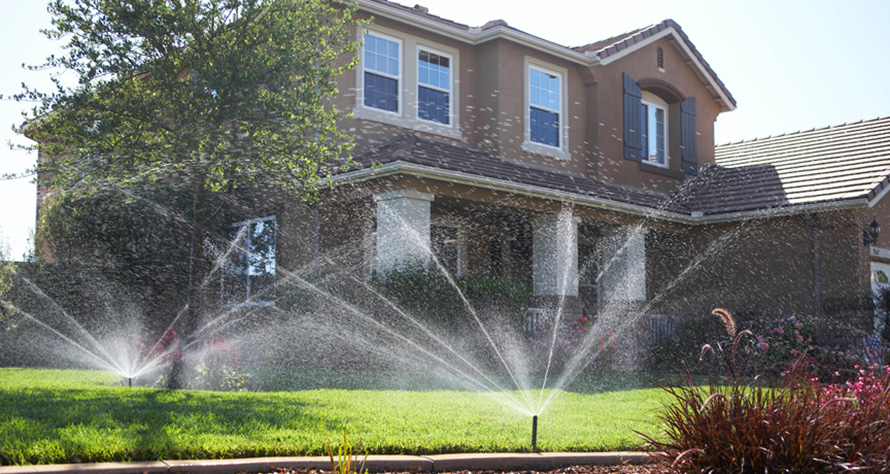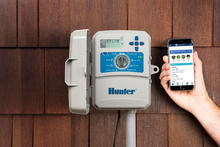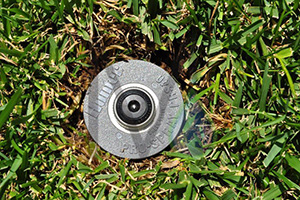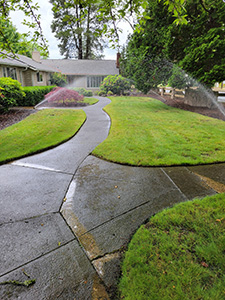How to Start Up Your Sprinkler System

As landscape contractors, we frequently hear from homeowners with questions about when and how to start up their sprinkler systems in the spring—especially if they have recently moved and are unfamiliar with their new home’s irrigation. Here is everything you need to know about starting up your sprinkler system, plus some basic information to help you familiarize yourself with your own system.
When to Start Up your Irrigation System
The best time to start up your sprinkler system is, of course, weather-dependent. Here in the Pacific Northwest, this can vary from year to year and depends on when the risk of freezing temperatures is past and rainfall has begun to subside. This can be anywhere from mid-April to mid-May or even June. The key is not drowning your lawn and garden by starting too soon, or waiting too long and allowing your landscape to dry out.
Irrigation System Spring Start-Up Checklist
Starting up your irrigation system is not as simple as throwing a switch or turning the dial on the controller from off to auto. To ensure everything is operating as it should and no maintenance is needed, follow this irrigation start-up checklist:
- Inspect and test the backflow preventer.
In the state of Oregon, property owners are required to have a backflow preventer installed with their irrigation system. The backflow assembly is connected to your home’s water pipes to prevent water from flowing back into the main water supply. The Oregon Health Authority also requires an annual backflow test by a state-certified backflow tester.
Landscape East & West Backflow irrigation technicians are trained and certified to inspect and test backflow prevention devices and can even submit the required reports to the city, county, and state on your behalf.
- Turn on the main water line to the irrigation system.
If your system was properly winterized last fall, the water to your irrigation system was shut off. You will need to re-open the main irrigation valve adjacent to the backflow preventer before you can run your sprinklers or drip lines.
- Inspect the irrigation controller.
 Most controllers are located inside a garage or shed, although they can also be located outside. Inspect the controller for any damage and turn the controller on to confirm it is functioning properly. You will also want to make sure the correct time is displayed and reset if necessary. Depending on the type of controller, you may also need to replace batteries. The role of the battery is to ensure that the programming remains active in the event of a power outage.
Most controllers are located inside a garage or shed, although they can also be located outside. Inspect the controller for any damage and turn the controller on to confirm it is functioning properly. You will also want to make sure the correct time is displayed and reset if necessary. Depending on the type of controller, you may also need to replace batteries. The role of the battery is to ensure that the programming remains active in the event of a power outage.
- Inspect irrigation valves.
Irrigation valve assemblies will age over time and can become damaged by extreme weather events. Before starting up your irrigation system, open any valve boxes and carefully inspect the valve assemblies for leaks or any signs of damage.
- Inspect all sprinkler heads.
 Even if your system was in perfect working condition when you turned it off for the winter, there is no guarantee it will be in the same condition when you start it up again in the spring. Sprinkler heads can become overgrown with vegetation or covered with debris, dirt, or gravel that has accumulated. You will want to ensure all sprinkler heads are free and clear of any impediments.
Even if your system was in perfect working condition when you turned it off for the winter, there is no guarantee it will be in the same condition when you start it up again in the spring. Sprinkler heads can become overgrown with vegetation or covered with debris, dirt, or gravel that has accumulated. You will want to ensure all sprinkler heads are free and clear of any impediments.
If you have rotor-style sprinkler heads, it is best to also remove the nozzle from each rotor and clean out any debris. You will need to replace any missing or damaged nozzles.
- Test the controller and all the sprinkler heads.
Using the controller, cycle through each zone in your irrigation system one at a time.
 Leave each zone on long enough for you to visually inspect each sprinkler head to ensure all heads are functioning properly and water is being dispersed effectively throughout each zone. If any sprinkler heads are leaning, you will need to straighten them to ensure proper coverage.
Leave each zone on long enough for you to visually inspect each sprinkler head to ensure all heads are functioning properly and water is being dispersed effectively throughout each zone. If any sprinkler heads are leaning, you will need to straighten them to ensure proper coverage.
- Set the controller for the season.
As rainfall changes with the seasons, so will your irrigation needs. Adjust your watering schedule to minimize overwatering during the rainier months and ensure efficient watering during the dry season. On the controller, set the desired frequency and length of time for each zone to best accommodate the needs of your landscape based on the season. If your controller is equipped with a weather sensor or rain collector, uncover it and clean it if necessary. If you do not have a smart controller, utilize the seasonal adjustment feature to manually adjust the timing on all zones to water less when it is cold (seasonal adjust to 80%) and more during the hot summer days (seasonal adjust to 110 – 115%). This will save you time instead of having to adjust all of the zones individually.
Premium Water Management Services (PWMS)
If you have recently moved and you are unfamiliar with your irrigation system, or if you would prefer to let a professional handle the annual inspection and maintenance, then you may want to consider a Premium Water Management Service (PWMS). This is a popular, stand-alone program we offer homeowners, whether or not we have installed their irrigation system. The program covers all of your routine irrigation maintenance needs, including the spring start-up—system inspection, test, and adjustments, and backflow test/reporting—plus winterization at the end of the season. Our PWMS customers also receive a 20% discount on any parts needed for irrigation repair and have the option of adding a mid-season system check and adjustment.
A lush and healthy landscape requires proper irrigation. Depending on the size of your property and the unique needs of your landscape, an efficiently designed and automated irrigation system that is well maintained is your best option. At Landscape East & West, we specialize in modern irrigation technology, system design, installation, and maintenance. Our fully trained and certified irrigation technicians are also ready to help you better understand your existing irrigation system and give you the peace of mind that everything is functioning as it should. Contact us today for more information or to start your Premium Water Management Service.
